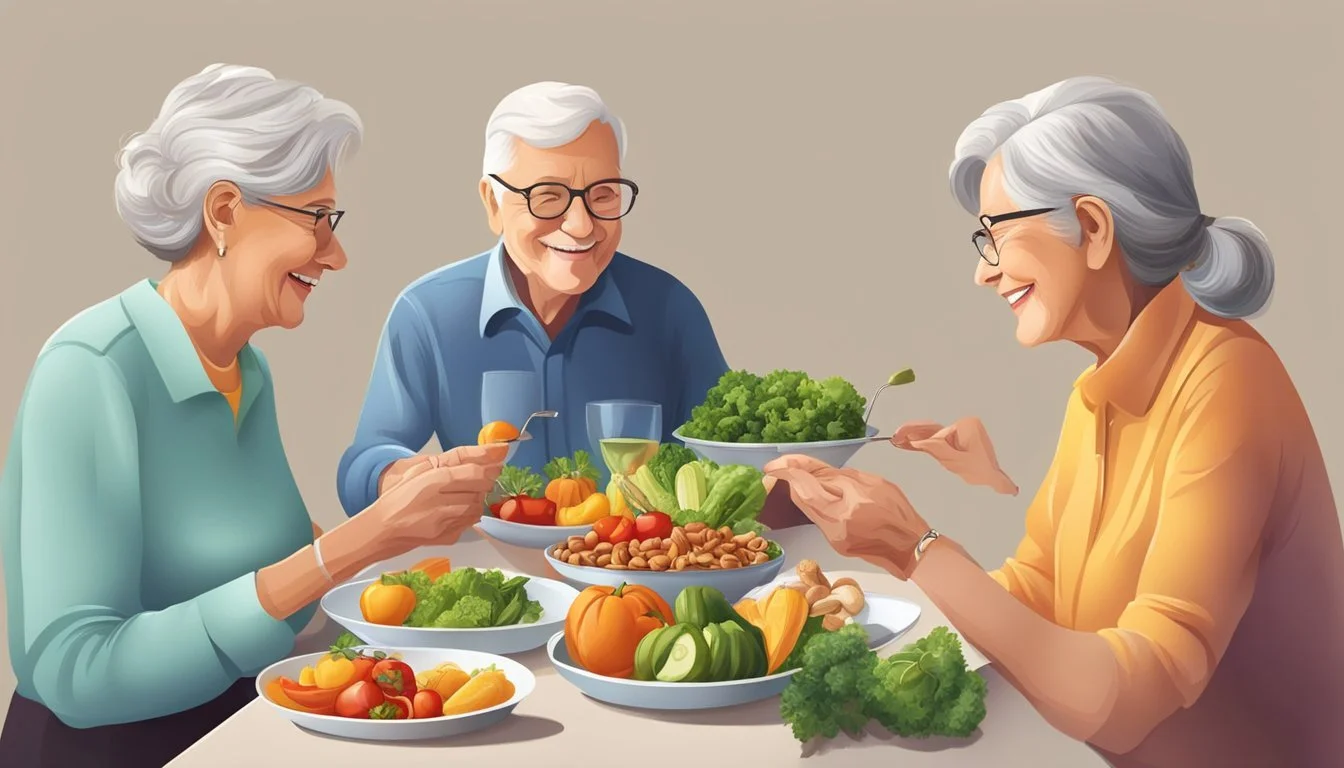Paleo Diet for Seniors
Benefits and Tips for Healthy Aging
The Paleo diet, often characterized by its emulation of the dietary patterns of our Paleolithic ancestors, constitutes an eating plan that excludes processed foods in favor of whole foods such as lean meats, fish, fruits, vegetables, nuts, and seeds. This diet is based on the presumption that modern humans are genetically adapted to the diet of their Paleolithic ancestors and, thus, can achieve optimal health by replicating their eating habits. An increasingly popular approach to nutrition, it draws on the idea that a diet of whole foods can lead to numerous health benefits, a notion that holds particular promise for the senior population.
For seniors who are looking to maintain or improve their overall health, the Paleo diet offers a framework for nourishment that aligns with anti-inflammatory and insulin-sensitizing principles. Considering the age-related rise in chronic conditions such as cardiovascular disease and type 2 diabetes, this dietary approach could be crucial. The Paleo diet's emphasis on nutrient-dense foods corresponds with seniors' nutritional needs by potentially aiding in the management of blood pressure, cholesterol levels, and glucose tolerance—all factors that are vital in the context of aging.
While the core tenets of the Paleo diet involve eating foods presumed to have been available to our ancestors, the adaptability of the diet means it is not a one-size-fits-all regimen. It can be tailored to accommodate the individual nutritional requirements of seniors, recognizing that their dietary needs may differ from those of the younger population. The focus of the Paleo diet on lean protein, for instance, supports muscle maintenance, an important consideration for aging bodies. In summary, adapting the Paleo diet to suit the specific health concerns and nutritional needs of seniors may support their wellbeing and quality of life.
Understanding the Paleo Diet
The Paleo Diet draws inspiration from the dietary patterns of our Paleolithic ancestors, emphasizing a return to whole foods that align with early human consumption.
Origins and Evolutionary Perspective
The Paleo Diet is rooted in the Paleolithic Era, which concluded around 10,000 years ago. During this time, humans relied primarily on hunting and gathering for nutrition. Proponents argue that the human body is genetically adapted to this type of diet, which originated from our hunter-gatherer ancestors, long before the advent of agriculture.
Core Principles and Foods Included
The core philosophy of the Paleo Diet is to consume foods presumed to have been available to humans before the agricultural revolution. This includes:
Fruits and vegetables: Rich in vitamins and fiber.
Lean meats and seafood: Sources of protein and omega-3 fatty acids.
Eggs: Highly nutritious and versatile.
Nuts and seeds: Good for snacks and rich in healthy fats.
The focus is on choosing nutrient-dense options that facilitate a high intake of vitamins, minerals, and antioxidants.
Foods to Avoid in the Paleo Diet
Certain food groups are excluded from the Paleo Diet based on the belief that they were not part of early human diets and may contribute to chronic diseases. These include:
Grains: Such as wheat, oats, and barley.
Legumes: Including beans, lentils, and peanuts.
Dairy: Milk, cheese, and other dairy products.
Processed foods and sugars: Emphasis is placed on avoiding processed items, additives, and high-sugar foods.
By eliminating these foods, the Paleo Diet aims to reduce the intake of food elements that may lead to inflammation or insulin resistance.
Health Benefits for Seniors
The Paleo Diet offers seniors specific health advantages, including better weight management and cardiovascular health, improved insulin sensitivity, and reduced inflammation—all crucial for aging healthily.
Weight Management
A Paleo Diet can promote weight loss and maintain a healthy weight in seniors. This diet prioritizes lean meats, fish, fruits, vegetables, and nuts, which can lead to a natural reduction in calorie intake without the need for complex calorie counting.
Improved Cardiovascular Health
For seniors concerned with heart disease, the Paleo Diet encourages the consumption of foods high in omega-3 fatty acids like wild-caught fish, which can improve heart health by lowering blood pressure and cholesterol levels.
Strengthened Insulin Sensitivity
By reducing intake of processed sugars and grains, the Paleo Diet can improve insulin sensitivity, which is particularly beneficial for seniors at risk of diabetes. A diet low in processed carbohydrates and high in fiber from fruits and vegetables can help manage blood sugar levels.
Reduced Inflammation
Chronic inflammation is a risk factor for many age-related diseases. The Paleo Diet includes a high intake of anti-inflammatory foods, such as leafy greens and berries, which may help lower the body's inflammation markers. This can be particularly beneficial for seniors suffering from conditions like arthritis.
Nutritional Considerations for Seniors
When adopting a Paleo diet, seniors must focus on obtaining essential nutrients that support bone health, immune function, and muscle maintenance. Proper intake of calcium, vitamins, minerals, and protein is critical for overall well-being.
Ensuring Adequate Calcium Intake
Calcium is vital for senior citizens to maintain bone density and prevent osteoporosis. A Paleo diet for seniors should include calcium-rich foods such as:
Leafy green vegetables (e.g., kale, broccoli)
Almonds
Canned fish with bones (e.g., sardines, salmon)
While dairy is typically excluded from a Paleo diet, seniors can meet their calcium needs with these alternatives.
The Importance of Vitamins and Minerals
Seniors need a variety of vitamins and minerals for optimal health. They should focus on:
Vitamin D: Essential for calcium absorption, which can be obtained from eggs, fatty fish, and sun exposure.
Vitamin B12: Important for nerve function and can be found in meat, fish, and eggs.
Magnesium: Helps with muscle function and is present in nuts, seeds, and leafy greens.
Incorporation of fruits and vegetables provides additional vitamins and minerals that are crucial for seniors' health.
Balancing Protein with Other Nutrients
Proper protein intake is necessary for seniors to prevent muscle loss. However, it should be balanced with other nutrients. Sources of protein in a Paleo diet include:
Lean meats
Fish
Eggs
Along with protein, seniors should consume adequate fiber from fruits and vegetables to support digestive health.
Potential Challenges and Risks
While the Paleo diet can offer a variety of health benefits for seniors, it's important to be aware of potential risks and challenges that may come with this dietary change.
Risk of Nutrient Deficiencies
A strict Paleo diet excludes certain food groups which may lead to nutrient deficiencies. For example, by eliminating dairy, seniors might experience a shortfall in calcium and vitamin D, both crucial for bone health. Seniors should be mindful of these potential gaps and consider appropriate food choices or supplementation to maintain a balanced nutritional intake.
Vitamin D: Found in limited quantities in foods like fish and eggs, but often needs supplementation, especially for those with limited sun exposure.
Calcium: Essential for bone health but typically found in dairy, which is excluded in Paleo. Alternative sources include dark leafy greens and fortified foods.
Considerations for Bone Health
A significant concern for seniors on the Paleo diet is maintaining bone health and reducing the risk of osteoporosis. Given the diet's exclusion of dairy, seniors need to proactively consume alternative sources of calcium and engage in weight-bearing exercises to strengthen bones.
Weight-bearing exercises: Activities like walking and strength training are vital for maintaining bone density.
Calcium sources: Include sardines, salmon, broccoli, and kale in the diet.
Addressing the Risk of Chronic Diseases
Seniors should be attentive to how the Paleo diet aligns with their unique needs for chronic disease management, especially concerning cardiovascular disease and cancer. Some facets of the Paleo diet, like the emphasis on lean meats and vegetables, can be beneficial for managing these risks, but the diet can be high in saturated fats from certain meat sources, which is a concern for heart health.
Saturated fats: Prefer lean cuts of meat and incorporate plant-based fats like avocados and nuts.
Fiber: The diet often lacks sufficient dietary fiber, important for digestive health and cancer prevention, so inclusion of high-fiber vegetables and fruits is critical.
Practical Tips for Adopting a Paleo Lifestyle
Adopting a Paleo lifestyle involves mindful meal planning, careful grocery shopping, and staying active. This section provides clear strategies to help seniors integrate these aspects into their daily routine.
Planning and Preparing Meals
Effective meal planning begins with a clear understanding of Paleo principles: focusing on meats, seafood, eggs, vegetables, fruits, nuts, and seeds while excluding grains, legumes, dairy, and processed foods. Seniors should consider preparing a meal calendar for the week to ensure a varied and balanced intake of nutrients. Batch cooking and portioning meals can simplify the process and make it easier to stick to the Paleo diet. A well-organized meal plan helps in avoiding the temptation of non-Paleo foods and reduces the stress of last-minute decisions.
Sample Meal Plan
Monday: Grilled salmon with steamed broccoli and mixed greens salad.
Tuesday: Stir-fried chicken with bell peppers and mushrooms over a bed of spinach.
Making Paleo-friendly Grocery Choices
When shopping, seniors should focus on purchasing whole, unprocessed ingredients. They may prefer grass-fed meats and organic produce, although these are not strict requirements of the Paleo diet. Reading labels is crucial to avoid products with added sugars and preservatives. It is helpful to organize a shopping list by food categories:
Proteins: Chicken, beef, fish
Vegetables: Kale, sweet potatoes, carrots
Fruits: Apples, berries, avocados
Fats: Olive oil, coconut oil, almonds
Incorporating Physical Activity
Physical activity is a key component of the Paleo lifestyle, complementing dietary changes with improved fitness. Seniors should aim for a mix of cardiovascular exercises, such as walking or swimming, and strength training, which can include bodyweight exercises or lifting light weights. It is important to choose activities that are enjoyable and suitable for one's fitness level to encourage consistent practice. Regular exercise enhances the benefits of a Paleo diet and contributes to overall well-being.
Paleo Diet Variations and Flexibility
While the Paleo diet is known for its emphasis on whole, unprocessed foods, several variations exist that cater to different health needs and preferences. These adaptations provide flexibility while maintaining the core principles of Paleo nutrition.
Autoimmune Paleo (AIP) Approach
The Autoimmune Paleo (AIP) approach is designed for individuals with autoimmune conditions. It involves a more stringent form of the Paleo diet, excluding nightshades, eggs, nuts, and seeds to reduce inflammation. The AIP diet is often used as an elimination diet to identify foods that may trigger an autoimmune response, followed by careful reintroduction to gauge tolerance.
Paleo-Ketogenic Diets
Combining principles from both the Paleo and ketogenic diets, the Paleo-ketogenic diet is high in fats, moderate in proteins, and low in carbohydrates. This diet aims to induce ketosis—a metabolic state in which the body burns fat for fuel instead of glucose—while still providing nutrient-dense, Paleo-approved foods. It can be particularly beneficial for seniors looking to manage their blood sugar levels and reduce their reliance on processed foods.
Inclusion of Non-Paleo Foods
Incorporating some non-Paleo foods into one's diet can offer dietary flexibility, making the Paleo diet more sustainable and personalized. Seniors may choose to include legumes, dairy, or grains that they tolerate well. It's crucial for individuals to listen to their bodies and incorporate foods that provide nutritional value without causing adverse effects.
Expert Opinions and Research
The adoption of the Paleo diet among seniors has garnered attention from health professionals. This section will explore the insights of registered dietitians and the findings from scientific studies regarding the Paleo diet for the elderly.
Insights from Registered Dietitians
Registered dietitians acknowledge the potential of the Paleo diet to offer a nutrient-rich and anti-inflammatory eating pattern to seniors. They underline the diet's focus on whole foods and its alignment with reducing the intake of processed fats and sugars. Dietitians note the importance of adapting the diet to accommodate the nutritional needs of the elderly, emphasizing the significance of a balanced intake that supports bone health and muscle maintenance.
Analysis of Scientific Studies
Scientific studies have suggested that the Paleo diet may contribute to improvements in blood pressure and cholesterol levels due to its emphasis on lean proteins and plant-based foods. Research indicates that this diet might also enhance glucose tolerance, which is particularly relevant for seniors with or at risk of developing type 2 diabetes. It should be noted that comprehensive studies are still required to ascertain the long-term effects of a Paleo diet specifically on senior populations.
Conclusion
Adopting a paleo diet can offer seniors numerous health benefits. This diet focuses on whole, unprocessed foods which are fundamental to reducing inflammation and optimizing nutrition. Seniors may find that by following a paleo dietary pattern, they experience improvements in health outcomes, such as lower blood pressure and cholesterol, and better glucose tolerance.
Lifestyle Adjustments for seniors interested in the paleo diet may include:
Choosing lean meats, fish, fruits, vegetables, nuts, and seeds
Avoiding processed foods, grains, legumes, and dairy products
Ensuring adequate carbohydrate intake from fruits and vegetables to manage blood sugar levels
The key to a successful paleo lifestyle for seniors lies in personalizing the diet to one's nutritional needs and physical capabilities. While the paleo diet can be nutrient-rich and beneficial, seniors should pay attention to bone health, digestive function, and energy needs.
Consulting healthcare providers before making dietary changes is imperative, as they can provide guidance tailored to individual health status and nutritional requirements. They can also help mitigate any potential risks associated with dietary restrictions, ensuring a balanced intake of all essential nutrients.
By focusing on natural, unprocessed foods and eliminating common inflammatory items from their diet, seniors can aim for an overall enhancement in quality of life and well-being.







